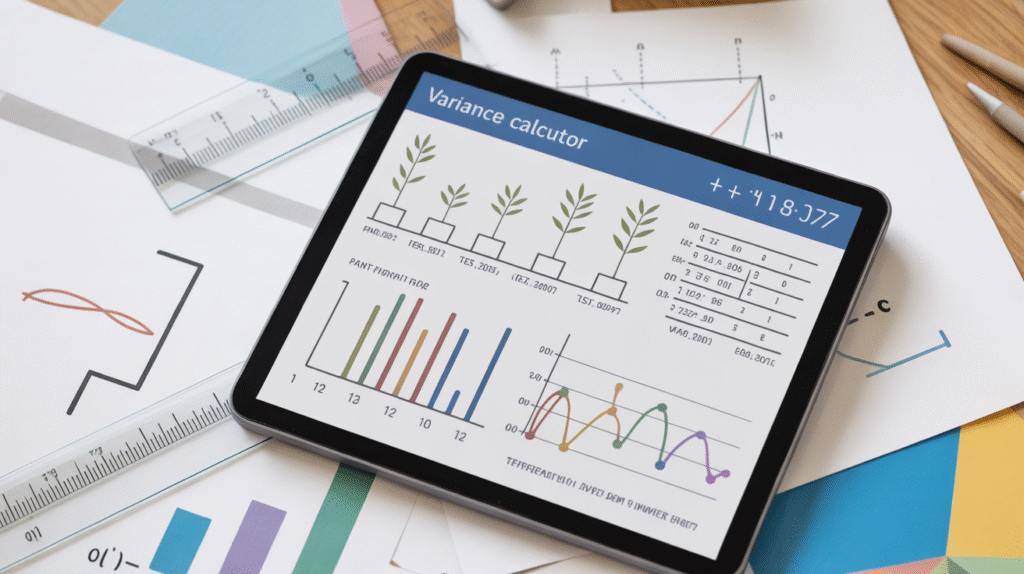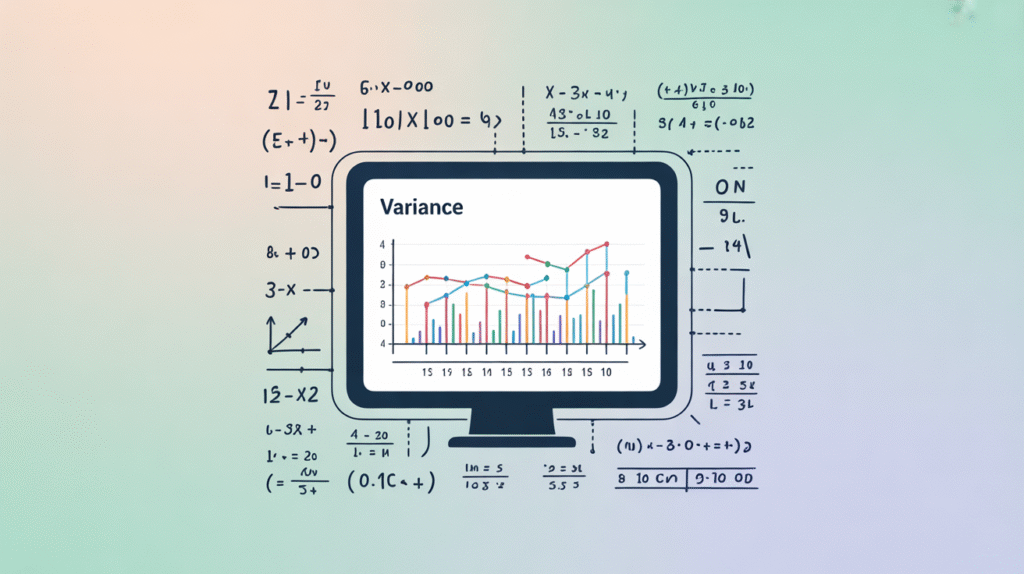Have you ever wondered how much your numbers are spread out? Maybe you measured the height of your plants, tracked your grades, or checked daily temperatures. Some days are high, some are low, and you want to know — how much do they vary? That’s where a variance calculator comes in handy.
A variance calculator helps you quickly find how spread out a set of numbers is. It’s a simple yet powerful tool used in math, science, finance, and everyday life. Whether you’re a student learning statistics, a teacher explaining data, or someone who loves understanding numbers, learning about variance and how to calculate it will make your data make more sense.
In this article, we’ll break down everything about variance and how to use a variance calculator — in plain English. Let’s dive in!
What Is Variance?

Variance is a number that shows how far values in a data set spread out from the average (mean).
Imagine you and your friends took a math test. If everyone scores close to the same number, the variance is small. But if one person scores 100 and another 50, the variance is much bigger because the scores are spread out more.
In simple terms, variance tells you how “spread out” your numbers are. It’s like measuring how much your data “wiggles” away from the average.
Mathematically, it’s the average of the squared differences between each value and the mean. Don’t worry if that sounds scary — a variance calculator will do all the hard math for you!
Why Is Variance Important?
Variance helps you understand data better. It tells you whether your data points are close together or scattered.
For example:
- In finance, investors use variance to measure the risk of a stock. High variance means big ups and downs in price.
- In education, teachers can see if students have similar test scores or wide differences.
- In sports, variance can show how consistent a player’s performance is.
When the variance is small, things are stable. When it’s large, things are unpredictable.
Knowing this helps you make smarter choices — whether you’re studying trends, investing money, or comparing results.
That’s why using a variance calculator can be so useful. It saves time and ensures accuracy when working with data.
How to Calculate Variance (Step-by-Step)

Let’s understand how variance is found manually before we use a calculator.
Here’s how you do it:
- Find the mean (average) of your data.
Add all numbers together, then divide by how many there are. - Subtract the mean from each number.
This shows how far each value is from the average. - Square each difference.
Squaring removes negative signs and makes differences positive. - Find the average of those squares.
This final number is your variance.
Here’s a quick example:
Data set = 4, 6, 8
- Mean = (4 + 6 + 8) ÷ 3 = 6
- Differences from mean: (4–6), (6–6), (8–6) = –2, 0, 2
- Squared differences: 4, 0, 4
- Variance = (4 + 0 + 4) ÷ 3 = 2.67
The variance here is 2.67 — small but meaningful!
Now imagine doing that for 50 numbers — that’s when a variance calculator becomes your best friend.
What Is a Variance Calculator?
A variance calculator is an online or digital tool that helps you find variance in seconds.
You simply enter your list of numbers, click “calculate,” and it instantly shows:
- The mean (average)
- The variance
- The standard deviation (which is just the square root of variance)
No more long math steps or mistakes.
A good variance calculator works for both sample variance and population variance — two slightly different formulas used depending on your data type.
Sample Variance vs. Population Variance

This part can confuse beginners, but it’s actually simple.
- Population variance is used when you have every number from the whole group.
Example: All students in your school.
Formula: divide by N (total count). - Sample variance is used when you only have part of the group.
Example: 30 students from your school, not all.
Formula: divide by N – 1 (one less than total count).
Why subtract 1? Because it helps make your estimate more accurate when you don’t have all the data.
Most variance calculators let you choose between sample or population before calculating.
How to Use a Variance Calculator
Using a variance calculator is super easy. Here’s how:
- Open a trusted online calculator.
You can search “variance calculator” and choose a reliable one. - Enter your data.
Type your numbers separated by commas (like10, 12, 15, 18, 20). - Choose the type.
Select “Sample” or “Population” depending on your data. - Click Calculate.
Instantly, you’ll see the mean, variance, and standard deviation.
That’s it! No more manual formulas or messy math. The variance calculator does all the work instantly and accurately.
Real-Life Examples of Variance
Let’s look at how variance appears in daily life:
1. Weather Forecasts
If you check temperatures over a week and they range from 70°F to 72°F, variance is small. But if they jump from 60°F to 90°F, the variance is big — meaning unpredictable weather.
2. Sports Performance
Imagine a basketball player scores 20, 21, and 19 points in three games. Low variance — very consistent. If they score 10, 30, and 25, variance is high — performance swings up and down.
3. Stock Market
Investors love low-variance stocks for stability and high-variance ones for potential big gains (but more risk).
4. School Grades
Teachers use variance to check how evenly students perform. Small variance = everyone understands well. High variance = mixed understanding.
Each example shows why using a variance calculator makes data insights quick and clear.
Variance vs. Standard Deviation
You’ll often see “standard deviation” along with variance. They are closely related.
Variance tells you how spread out the data is, but it’s in squared units (like cm² or points²).
Standard deviation is just the square root of variance — it brings the number back to normal units, making it easier to interpret.
If variance = 9, then standard deviation = √9 = 3.
A variance calculator usually gives both values together, so you can see the spread and the average difference from the mean at once.
Benefits of Using a Variance Calculator
Here’s why every student, teacher, and data lover should use a variance calculator:
- Saves time: No need to do long calculations.
- Prevents mistakes: Accurate results every time.
- Works for big data sets: Handle dozens or hundreds of numbers easily.
- Shows other stats too: Many calculators also display mean, median, and standard deviation.
- User-friendly: Anyone can use it — no advanced math needed.
It’s like having a smart math assistant that never gets tired or makes errors!
When Should You Use a Variance Calculator?
You can use it anytime you deal with data. Common cases include:
- Analyzing survey results
- Comparing product performance
- Tracking school test scores
- Measuring company sales data
- Studying scientific experiments
- Reviewing fitness or health progress
Whenever you have a list of numbers and want to know how much they differ, a variance calculator gives the answer fast.
Choosing the Best Variance Calculator
Not all calculators are the same. When choosing one online, look for these features:
- Clear input box for your data
- Option to choose sample or population variance
- Instant calculation and detailed results
- No ads or pop-ups
- Free and secure
Bonus tip: Some calculators also let you export results or show graphs — perfect for school or reports.
Common Mistakes to Avoid
Even with calculators, mistakes can happen. Here’s what to watch for:
- Typing errors: Double-check your numbers before clicking “calculate.”
- Wrong type selection: Choose sample or population correctly.
- Confusing variance with standard deviation: They’re different but related.
- Ignoring outliers: One extreme value can increase variance a lot.
A good variance calculator handles these well, but accuracy starts with careful input.
Tips for Learning Variance Better
Here are some simple tips if you’re just starting out:
- Practice with small data sets first.
- Visualize your data — seeing helps you understand spread.
- Use a calculator to check your manual math.
- Play with examples — test different number sets to see how variance changes.
Once you practice a bit, you’ll see how easy and useful variance can be in everyday life.
FAQs About Variance Calculator
1. What is a variance calculator used for?
A variance calculator helps you find how much your data varies from the average. It’s used in math, science, finance, and many other fields to measure consistency and spread.
2. What’s the difference between variance and standard deviation?
Variance measures the average squared distance from the mean. Standard deviation is the square root of variance — showing spread in original units.
3. Can I use a variance calculator for any data set?
Yes! Whether your data has 5 numbers or 500, a variance calculator works instantly. Just make sure your data is accurate.
4. Do I need to understand the formula to use one?
No. The calculator does all the math for you. But learning the formula helps you understand why the number matters.
5. How accurate are online variance calculators?
Most reliable calculators are extremely accurate. Just ensure you use a trusted website with clear options and results.
6. Is variance always a positive number?
Yes. Because differences are squared, variance is always positive — even if your numbers include negatives.
Conclusion: Make Data Simple with a Variance Calculator
Understanding numbers doesn’t have to be hard. A variance calculator turns complex math into simple, instant answers.
It helps you see whether your data is steady or scattered — useful for school, business, or personal tracking. Once you start using one, you’ll wonder how you ever worked without it!
So next time you have a list of numbers and want to see how they differ, try a variance calculator. It’s fast, accurate, and surprisingly fun to use.
Final Thoughts
- Variance shows spread.
- A variance calculator saves time and boosts accuracy.
- Use it often to understand data better in any area of life.
Numbers tell stories — and with a variance calculator, you’ll understand those stories more clearly than ever before.




